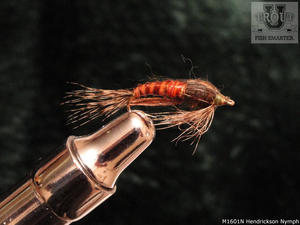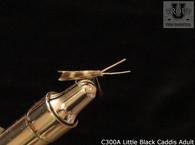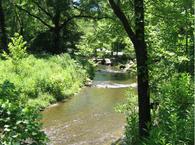
To continue our discussion of mayfly nymphing tactics, we need to understand a little about entomology. The Hendrickson nymphs are not excellent swimmers or clingers so they are in the crawling or "catch all" category of mayflies. They are important because the trout can eat them more easily than the clinger type of mayflies like the Quill Gordons and the March Browns.
They make their home in moderate steady water flowing smooth, not plunging or turbulent water. They can sometimes be found in that portion of the riffles where the water flows moderately. They are especially fond of the tail end of pools.
Unlike the swimmers, they can not swim away fast enough to escape the hungry trout; and unlike the clingers who hide under rocks, they are especially vulnerable to the feeding trout. The bottom of the stream needs to be small to medium size cobble stones, gravel, or sand. When these conditions, exist you will almost always find a good supply of Hendrickson nymphs. The trout often position themselves at the end of a current seam that is collecting the emerging nymphs and just suck them up as they drift by.
Now that we have located the Hendrickson nymphs, we can concentrate on nymphing tactics. Now in many areas of the country, for about two weeks up until the time they hatch, the nymphs are even more subject to being eaten by trout and an imitation of the Hendrickson nymph will be deadly. This is one fly you can drop down from a dry fly used as an indicator. This nymphing tactic is used effectively by George Daniel who lives in Lock Haven Pa, and who is the national Fly Fishing Champion.
Fish in an upstream or slightly up and across direction and remember to fish the tail ends of the runs. Start at the end of the fast water where it slows down to a moderate speed or fish a slow moving current seam. Also, if you locate a pool with the right type bottom and depth, cast well ahead to cover the shallow water at the end of the pool. If you wade up to the end of the pool, you may have already spooked the trout that were feeding on the Hendrickson nymphs. More





